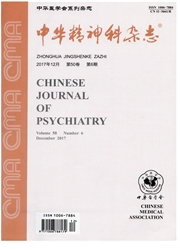

 中文摘要:
中文摘要:
目的探讨抑郁症患者对情感刺激的行为学反应模式及其相关的杏仁核时程反应过程。方法12例首次发病、未经治疗的抑郁症患者(抑郁症组)和13名健康个体(健康对照组)对观看正性、中性和负性情绪图片的愉悦度等评分;并在被动注视任务下行功能磁共振成像,采用感兴趣区分析方法,比较两组杏仁核在不同情绪图片任务组块间的血氧水平依赖(BOLD)信号时间反应特征。结果(1)抑郁症组情绪图片愉悦度评分[正性:(6.6±0.2)分;中性:(4.7±0.1)分]低于健康对照组[分别为(7.7±0.2)分和(5.1±0.1)分],负性情绪图片评分[(3.4±0.3)分]高于健康对照组[(2.2±0.2)分;P〈0.01]。(2)对正性情绪图片任务,两组间右侧杏仁核存在“组×时间”交互作用(P=0.002);抑郁症组杏仁核BOLD信号变化率为(0.02±0.09)%,激活时间后移至Block2。对负性情绪图片任务,两组间左侧杏仁核有“组×时间”交互作用(P=0.008),右侧杏仁核存在组主效应(P=0.007)和时间主效应(P=0.016),抑郁症组BOLD信号变化率低于(-0.06±0.14)%。结论杏仁核是抑郁症患者丧失愉悦体验和情绪低落的神经基础之一。
 英文摘要:
英文摘要:
Objective To explore the behavioral and related amygdalar temporal response to emotional pictures in individuals with major depressive disorder ( MDD). Methods Functional magnetic resonance imaging (fMRI) was adopted to examine the neural substrates of emotional pictures processing in 12 first-episode unmedicated MDD subjects (MDD) and 13 healthy controls (HC). Analyses were focused on the temporal dynamics of the blood-oxygen level dependant (BOLD) signal change in the amygdala across blocks of positive, neutral and negative emotional pictures. The crude score to emotional pictures was also recorded. Results ( I ) The crude score was ( 6. 6 ± 0. 2 ) to positive pictures and (4. 7 ± 0. 1 ) to neutral pictures in depressed subjects, lower than that in HC (P 〈 0. 01 ), and (3.4 ± 0. 3 ) to negative pictures in depressed subjects, which was higher than that in HC (2. 2 ±0. 2, P 〈0. 01 ). (2) The bilateral amygdala showed attenuated and delayed response to the positive pictures, in which the right amygdala showed "group× time" interaction effect to positive pictures (P = 0. 002). For the negative pictures, there was "group × time" interaction effect in the left amygdala (P = 0. 008) and group main effect in the right amygdala (P = 0. 007), with the attenuated BOLD signal change in MDD group. Conclusions It suggests that amygdala is one of the key neural substrates to the character of the depressed mood or loss of interest in individuals with MDD. Depressed subjects show the attenuated and blunted behavioral and amygdala response to emotional stimuli, which support the hypothesis of the unspecially blunted emotional response in major depressive disorder.
 同期刊论文项目
同期刊论文项目
 同项目期刊论文
同项目期刊论文
 期刊信息
期刊信息
